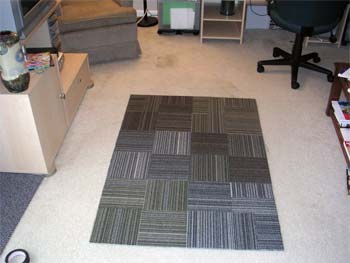Thinking Machine Chess Game
One of my readers has pointed out to me a Chess game that shows you what it’s thinking. Check it out.

David Kadavy is author of Mind Management, Not Time Management, The Heart to Start & Design for Hackers.
One of my readers has pointed out to me a Chess game that shows you what it’s thinking. Check it out.
With one eye glued to your TV tonight, glue your other eye to this well-designed interactive map illustrating party distribution for the 2004 election. There are also graphics illustrating past elections, and the progression of approval ratings throughout the campaign. The graphic when you click on “electoral votes” above the map communicates very well.
Friday night I saw Alexander Payne‘s newest masterpiece, Sideways in which the lonely, divorced Miles (Paul Giamatti) takes his soon to be wed friend, Jack (Thomas Haden Church), on a week-long bachelor party of sorts through California’s wine country.
In preparation for dressing up as Holden Caulfield for Halloween (I actually went as Pedro from Napoleon Dyanmite), I have been re-reading JD Salinger’s The Catcher in the Rye, and I noticed an analogous relationship between at least a portion of Catcher and Alexander Payne’s movies (most notably, Election, About Schmidt, and Sideways). In Sideways, there is a scene where Maya (Virginia Madsen) explains to Miles that she likes wine because it is living, and is different every day. The day that you open it, it tastes different than it would be on any other day. Also, in Catcher, there is a part where Holden, while walking to the Museum of Natural History ponders:
“The best thing, though, in that museum was that everything always stayed right where it was. Nobody’d move. You could go there a hundred thousand times, and that Eskimo would still be just finished catching those two fish, the birds would still be on their way south, the deers would still be drinking out of that water hole, with their pretty antlers and their pretty, skinny legs, and that squaw with the naked bosom would still be weaving that same blanket. Nobody’d be different. The only thing that would be different would be you. Not that you’d be so much older or anything. It wouldn’t be that, exactly. You’d just be different, that’s all. You’d have an overcoat on this time. Or the kid that was your partner in line the last time had got scarlet fever and you’d have a new partner. Or you’d have a substitute taking the class, instead of Miss Aigletinger. Or you’d heard your mother and father having a terrific fight in the bathroom. Or you’d just passed by one of those puddles in the street with gasoline rainbows in them. I mean you’d be different in some way–I can’t explain what I mean.”
This alone seems like a rather weak link, but then I remembered, didn’t Mr. McAllister (Matthew Broderick) get a job at the Musuem of Natural History after he moved from Omaha? There is also a scene in About Schmidt where Warren (Jack Nicholson) visits The Great River Platte Road Archway Monument, and views exhibits similar to those described in Catcher. Perhaps even Warren’s deceased wive’s Hummel figures serve as this static artifact that contrasts with the constant change in the lives of the characters surrounding it.
I’m sure this concept of people being in a constant state of flux, contrasted by something unchanging is a literary theme that originates from before Salinger, but It made me wonder.
What do you think?
This month’s Wired includes a CD full of music with Creative Commons licenses. You can download the tracks for free, share them all you want, and even sample music to create your own tracks, which you can then share and even (for most of the tracks), sell.
Artists on the CD include Beastie Boys, Chuck D, The Rapture, and I was please to see the greatest band on the planet, Spoon in the mix.
Remember Scott? Renee investigated Scott a little further than I did, and discovered Scott’s blog. There are some great discussions on there about general etiquette. One particular post about the Caller ID Debate is thought and comment provoking.
I think prescriptive, laundry list, advice like this can be dangerous, however. It sort of reminds me of reading an article on “How to Get Laid” in “Maxim” or “Playboy”: -furrow your brow and try to look sensitive – act like you are listening -say “I understand” alot. The thing is that the advice Scott gives are things a considerate person would do, and following the advice (unless you memorize alot of advice) won’t necessarily make you a considerate person.
But, it all is built upon a logical framework of considerateness, and if one were to read enough of this advice, they may pick up on this logic and apply it to new situations. It seems Scott may be aware of this, though. In his “Caller ID Debate” post, he points out the offending action, and then explains why it is inconsiderate, thus assisting the reader in developing a logical framework of considerateness.
I’ve found a great new use for the old carpet tile samples my Architecture firm gets. I taped together some matching samples to make a rug for my pad.

You may have noticed that I haven’t posted for awhile. Don’t worry, I’m not a blog abandoner, I have been investing my blogging time in transferring my blog from blogger to Movable Type, and it has been a much more involved process than I had anticipated. If you’ve been considering making the move, I suggest that if you are in fact going to do it, do it as soon as possible.
One of my readers has brought to my attention Scott, a guy who wears a name tag every day. Apparently, he started doing so as an experiment, and it has introduced him to the wonderful world of spontaneous human interaction. This name tag has become his front porch that says “Hey! Come on up and chat!” and people tend to be more friendly now that he has his name tag on.
This piqued my interest because I often lament the lack of spontaneous human contact that I blame on the increased use of the private automobile and developments such as strip malls and suburbs. This is especially pronounced in a place like Omaha. People have pushed each other so far from one another that the ice that needs breaking is getting thicker and thicker. The result, in my mind, is that instead of having sustainable social networks, people have compartmentalized their lives and now must resort to dating services to find suitable partners, and “networking events” – specifically for exchanging business cards – to establish business “relationships.” I can theorize so many other repercussions and repercussions of the repercussions that I’m afraid to get any farther into it.
Next time you are walking down the street, and by some miracle, it happens to be a street on which there is another person other than yourself walking in the opposite direction, try to make eye contact with that person. It can be disturbingly difficult. You may want to try one of Scott’s 52 ways to build your front porch.
I would have liked to have posted this at a more appropriate time, but better late than never. If you dig back into your archives of the Omaha World Herald, to the Sunday, September 24th edition, you will see the cover of the AIA Nebraska Architecture insert, which was designed by me. If you missed it the first time around and can’t find it in your archives, this is what it looked like.

I would have posted it sooner, but it didn’t cross my mind until one of my readers encouraged me to do so. Apparently, this is the first of the many years of Architecture inserts that has had its cover designed by someone other than someone in the OWH’s fine staff. Every year, the insert announces the AIA Nebraska Honor Award winners.
Looking through my webstats, it seems that someone has been translating kadavy.net through Tha Shizzolator.
Glad to see I’m reaching out to other cultures.